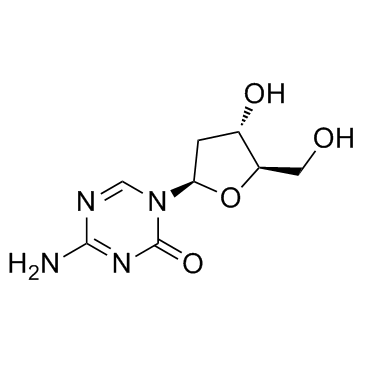Decitabine

Decitabine structure
|
Common Name | Decitabine | ||
|---|---|---|---|---|
| CAS Number | 2353-33-5 | Molecular Weight | 228.205 | |
| Density | 1.9±0.1 g/cm3 | Boiling Point | 485.8±55.0 °C at 760 mmHg | |
| Molecular Formula | C8H12N4O4 | Melting Point | ~200 °C (dec.) | |
| MSDS | Chinese USA | Flash Point | 247.6±31.5 °C | |
| Symbol |


GHS07, GHS08 |
Signal Word | Danger | |
|
The high mobility group A2 protein epigenetically silences the Cdh1 gene during epithelial-to-mesenchymal transition.
Nucleic Acids Res. 43(1) , 162-78, (2015) The loss of the tumour suppressor E-cadherin (Cdh1) is a key event during tumourigenesis and epithelial-mesenchymal transition (EMT). Transforming growth factor-β (TGFβ) triggers EMT by inducing the expression of non-histone chromatin protein High Mobility Gr... |
|
|
Epigenetic variation in the Egfr gene generates quantitative variation in a complex trait in ants.
Nat. Commun. 6 , 6513, (2015) Complex quantitative traits, like size and behaviour, are a pervasive feature of natural populations. Quantitative trait variation is the product of both genetic and environmental factors, yet little is known about the mechanisms through which their interacti... |
|
|
Flow-dependent epigenetic DNA methylation regulates endothelial gene expression and atherosclerosis.
J. Clin. Invest. 124(7) , 3187-99, (2014) In atherosclerosis, plaques preferentially develop in arterial regions of disturbed blood flow (d-flow), which alters endothelial gene expression and function. Here, we determined that d-flow regulates genome-wide DNA methylation patterns in a DNA methyltrans... |
|
|
Epigenetic modulation of the muscarinic type 3 receptor in salivary epithelial cells.
Lab. Invest. 95(2) , 237-45, (2015) Muscarinic receptors, particularly the type 3 subtype (M3R), have an important role in exocrine secretion. M3R normally function in HSG cells originated from human submandibular gland ducts, but not in A253 and SGT cells, derived from human submandibular carc... |
|
|
Epigenetic alteration of the purinergic type 7 receptor in salivary epithelial cells.
Biochem. Biophys. Res. Commun. 466 , 704-10, (2015) Purinergic receptors, particularly type 7 (P2RX7), are involved in apoptotic cell death. However, the expression and function of P2RX7 are suppressed in HSG cells. In the present study, we explored whether P2RX7 function is regulated by epigenetic alteration ... |
|
|
Dickkopf-1 induces apoptosis in the JEG3 and BeWo trophoblast tumor cell lines through the mitochondrial apoptosis pathway.
Int. J. Oncol. 46 , 2555-61, (2015) Gestational choriocarcinoma is a high-grade malignant tumor. In this study, the effects of Dickkopf-1 (DKK1) on a human trophoblast cell line was examined by using both in vitro and in vivo assays. DKK1 was observed to induce apoptosis and inhibit proliferati... |
|
|
Cheminformatics analysis of assertions mined from literature that describe drug-induced liver injury in different species.
Chem. Res. Toxicol. 23 , 171-83, (2010) Drug-induced liver injury is one of the main causes of drug attrition. The ability to predict the liver effects of drug candidates from their chemical structures is critical to help guide experimental drug discovery projects toward safer medicines. In this st... |
|
|
Development and validation of a HILIC-MS/MS method for quantification of decitabine in human plasma by using lithium adduct detection.
J. Chromatogr. B. Analyt. Technol. Biomed. Life Sci. 969 , 117-22, (2014) A highly sensitive, selective, and rugged quantification method was developed and validated for decitabine (5-aza-2'-deoxycytidine) in human plasma treated with 100μg/mL of tetrahydrouridine (THU). Chromatographic separation was accomplished using hydrophilic... |
|
|
Identification of HERC5 and its potential role in NSCLC progression.
Int. J. Cancer 136(10) , 2264-72, (2015) For better lung cancer diagnosis and therapy, early detection markers of tumor dissemination are urgently needed, as most lung cancers do not show symptoms until extensive metastasis formation has already taken place. Our previous studies showed that in non-s... |
|
|
Wnt inhibitory factor 1 (WIF1) is a marker of osteoblastic differentiation stage and is not silenced by DNA methylation in osteosarcoma.
Bone 73 , 223-32, (2015) Wnt pathway targeting is of high clinical interest for treating bone loss disorders such as osteoporosis. These therapies inhibit the action of negative regulators of osteoblastic Wnt signaling. The report that Wnt inhibitory factor 1 (WIF1) was epigeneticall... |